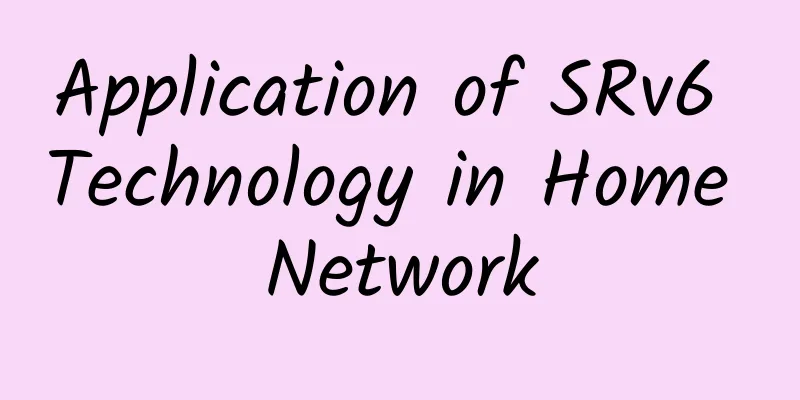Application of SRv6 Technology in Home Network

Labs GuideIn order to adapt to the development of emerging digital home services such as cloud games, high-definition video calls, AR/VR, etc., China Mobile's home network capabilities need to provide mutually isolated and quality-guaranteed sliced networks according to business characteristics to provide users with a good business experience. Based on the computing network infrastructure, China Mobile has built a home computing network capability layer focusing on "lightweight devices + containerized plug-ins + deterministic networks" to support home business applications, achieve lightweight home terminals, flexible home business deployment, and high-quality home broadband networks. 1. SRv6 ConceptSegment Routing (SR) is a source routing technology that assigns a Segment ID to each node or link. The head node combines these Segment IDs to form a Segment List and directs packets to be forwarded according to the Segment List, thereby realizing the programmability of the network. Currently, Segment Routing technology mainly has two implementations: SR-MPLS and SRv6. Among them, SR-MPLS is a Segment Routing implementation based on the MPLS data plane, and its SID is the MPLS label (Label); SRv6 (Segment Routing over IPv6, segment routing based on IPv6) is a Segment Routing implementation based on the IPv6 data plane, and its SID is the IPv6 address. SRv6 combines the source routing advantages of Segment Routing with all the characteristics of IPv6, and has multiple network programming spaces, which is in line with the SDN (Software Defined Network) concept. 2. SRv6 Implementation Principle2.1 SRH packageSRv6 implements segment routing by inserting a routing extension header SRH (Segment Routing Header) into the IPv6 packet header to carry segment transmission information. SRH contains a Segment List represented by a SID list with IPv6 address characteristics. The destination address of the packet will be updated segment by segment according to the Segment List, thereby completing segment-by-segment forwarding. The SRv6 message format is shown in Figure 1. The fields contained in the SRH are explained as follows: 2.2 SID DefinitionThe routable 128-bit SID is usually divided into three parts: Locator, Function, and Arguments. The length of each part is flexibly defined according to actual needs.
2.3 Segment TypeSRH directly uses IPv6 addresses to represent segments, which can flexibly support a wide range of types and combine different types of segments to complete specific functions. Generally speaking, segments can be divided into two categories: segments that represent path information and segments that represent service information. 3. SRv6 forwarding processP1 and P2 simulate backbone network devices, PE1 and PE2 simulate backbone network edge devices, and CE1 and CE2 customer access devices Host1 and Host2 act as clients and servers. During the forwarding process, the changes in the destination IP, Segment list encapsulation, SL, Last Entry and other fields can be seen in the pcap package. 3.1 Client access server uplink pathHost1->CE1->PE1->P1->CE2->Host2 CE1: picture PE1: picture P1: picture PE2: picture CE2: picture picture 3.2 Client access server downstream pathHost2>CE2->PE2->P2->CE1->Host1 CE2: picture picture PE2: picture P2: picture PE1: picture CE1: picture picture IV. SRv6 Advantages
5. SRv6 Application Scenarios5.1 Main Application Scenarios of SRv65.2 SRv6 Home Application ScenarioThe traffic is encapsulated in APN6 through the cloud gateway, and the customized service traffic is imported into the SRv6 acceleration network through the diversion strategy to realize the intelligent scheduling of home broadband services. VI. Summary and OutlookIPv6 has always been a highly concerned issue in various countries. It is also the foundation for the development of the next generation of the Internet and an important new technology application of the new generation of information technology in my country's strategic emerging industries. With the maturity of SRv6 technology, the application and deployment of IPv6 in the existing network will be accelerated. As a new generation of IP bearer protocol, SRv6 can simplify and unify traditional complex network protocols, and will be widely used in home broadband business scenarios in computing power networks, network intelligent scheduling, service orchestration, and other aspects. |
<<: A “cat” walking alone on a narrow road: Cat.1 and narrowband communications (I)
>>: POTN: The Future of Optical Transport Networks
Recommend
Why does TCP need a three-way handshake?
[[285361]] First, let's briefly introduce the...
Forty-five kinds of traditional knowledge about optical fiber and optical cable
1. Briefly describe the composition of optical fi...
What went wrong with HTTP/2? It’s about to be deprecated after just two years of success! ?
[[357747]] There has been a lot of news about HTT...
What is the transport layer protocol?
Transport layer protocols are an important part o...
Deeply cultivating integrated streaming media solutions, Yunfan Acceleration CDN obtains license from the Ministry of Industry and Information Technology
On September 6, the Ministry of Industry and Info...
4G has not been retired yet, but the global 5G network speed has begun to shrink: down by 39%. What do you think?
Have you used 5G? How does the network speed feel...
Huawei Network Energy "Innovation" on the Road
[51CTO.com original article] Introduction: "...
LOCVPS brings you cool autumn, 60% off on monthly VPS in Singapore
LOCVPS offers special events for different packag...
EtherNetservers: Los Angeles/New Jersey/Miami VPS annual payment starts at $14.95, supports Alipay/PayPal payment
EtherNetservers released the latest promotion in ...
Frontier | The Internet of Vehicles security ecosystem is taking shape
Internet of Vehicles Security Requires a Platform...
A Simple Explanation of Decentralized Applications
[[397123]] In this article, we will explain what ...
HostNamaste: 128G-8TB large hard disk VPS monthly payment starts at $4.99, 2G memory special VPS annual payment starts at $36, Los Angeles & Dallas data centers
HostNamaste recently promoted special annual VPS ...
A Brief Discussion on WebSocket Protocol-RFC 6455
Labs Guide Before the emergence of WebSocket, the...
The next step for the intelligent interconnection of all things: real-time interaction may become the water and air of the metaverse
On October 22-23, the RTE2021 Real-time Internet ...
How does millimeter wave technology unleash the future potential of 5G?
Currently, the major 5G development countries in ...









